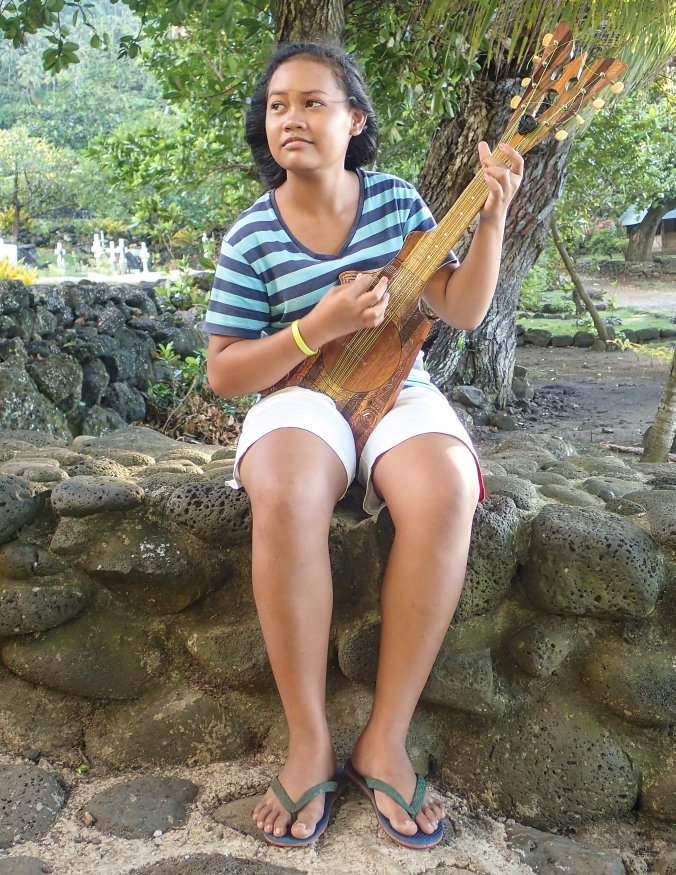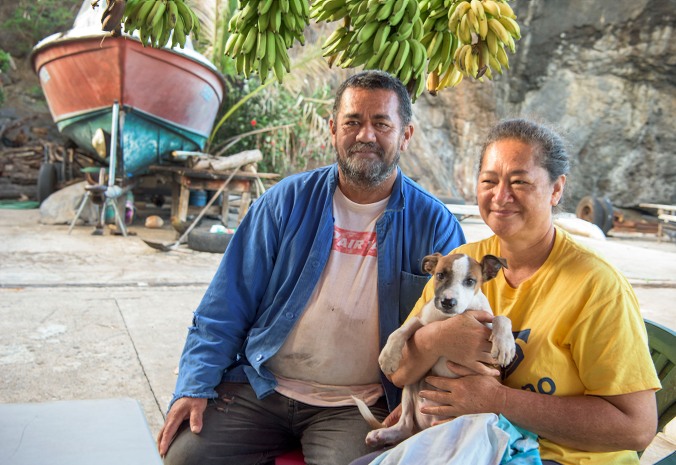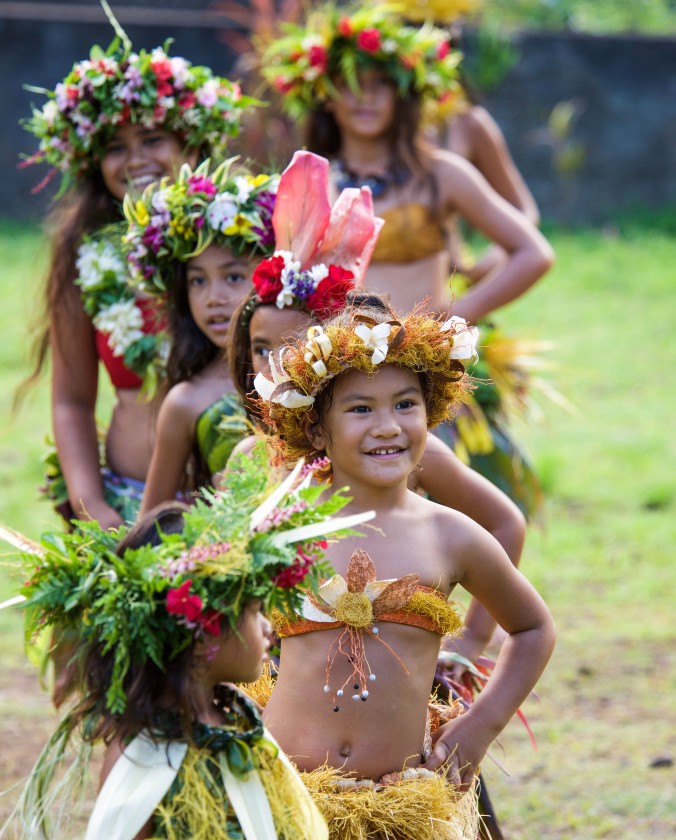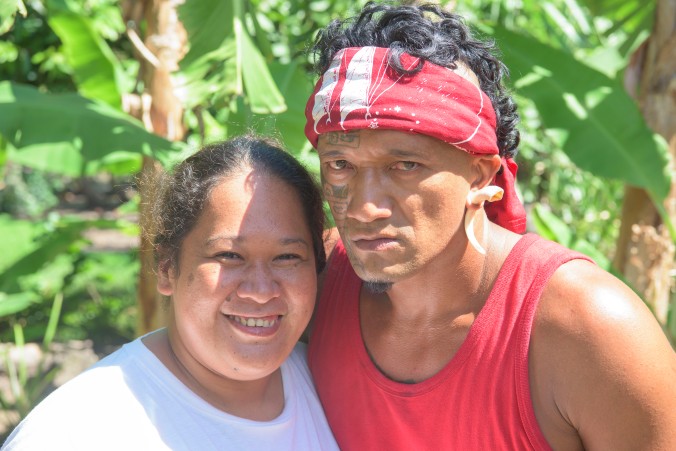
She could have just walked off the canvas of a Paul Gauguin painting. Photo: © Jeffrey Cardenas
For nearly a month it was as if Flying Fish had been sailing off the face of the earth. Then, at sunset on one clear afternoon, the peak of Fatu Hiva in the Marquesas was outlined on the horizon. By morning our anchor was secure at one of the great landfalls of ocean voyaging, the exquisite Bay of Virgins. Towering basalt cones resembling giant phalluses mark the entrance to the bay. French sailors originally named it the Baie des Verges (Bay of Penises). When the missionaries arrived they were outraged so they inserted the letter “i” making it the Baie des Vierges, which translated to Bay of Virgins (as if somehow that made the name less provocative.) Meanwhile, the indigenous Marquesans must have thought all of this was hilarious. Until, of course, they realized that the arrival of outsiders was literally wiping their civilization out of existence.
The Marquesan name for this group of 10 islands is Fenua Enata (Land of Men). The archipelago covers over 1,500 square miles of the South Pacific. It is a land of crenellated mountains, waterfalls, deep fertile valleys, and a dark coastline pounded by relentless surf. As early as 500 AD, seafaring Marquesans sailed and paddled their oceanic canoes thousands of miles to the islands now known as Hawaii, Easter Island, and New Zealand. A thousand years later, Europeans were following the same sea routes. In 1595, Spaniard Don Alvaro de Mendaña y Neyra sighted the Marquesas by chance. He thought the islands to be uninhabited but near Tahuata hundreds of light-skinned natives, naked, tattooed, and unarmed, paddled out in canoes and boarded the ship. Mendaña ordered a gun fired and the frightened natives jumped overboard. Then the Spaniards began shooting the Marquesans as they swam to shore. To be certain that nobody would forget his legacy Mendaña carved his name and date into a rock—and then left three bodies hanging from trees in a nearby village. When he departed, Mendaña left three large crosses and over 200 dead Polynesians in his wake. In the years that followed slavery, alcohol, firearms, and syphilis would further reduce the population until 95 percent of the indigenous people of the Marqueseas had died.
It is with this history in mind that I pull the dinghy of Flying Fish quietly into the bay at Tahuata where Mendaña had caused so much mayhem on his visit a half a millennium ago. A corridor of banyan, cashew, and wild almond trees shade a cobblestoned walkway. A lazy dog barely twitches an eye as I walk by. The foundation of a me’ae, an ancient Marquesan place of worship, is situated on high ground overlooking the bay. This me’ae would have most certainly been here when Mendaña arrived. Nearby, I hear the soft sound of sweet music from a ukulele. A young girl who seems to have stepped directly out of a Gauguin painting is playing the instrument. She sits on a rock wall near the cemetery of a Catholic church. A three or four-year-old boy, naked, dances soundlessly to the music. I sit nearby and the girl acknowledges me with a smile. Then she continues to play an enchanting set of chords as if she is the only person in this world who can hear the music.
The island of Fatu Hiva was impossibly scenic. Tahuata was spiritual. But Hiva Oa was the island where Paul Gauguin would choose as his final resting place. The life and death of Gauguin has fascinated researchers for over a century. He arrived in the Marquesas in 1901. Gauguin had quit his job in France as a stockbroker; he abandoned his wife and five children, and then sailed to Polynesia where his artistic genius blossomed. He built a two-story house in Hiva Oa with wooden frames on which he carved his favorite epigrams including “Soyez amoureuses et vous serez heureuses (Be in love and you will be happy). Gauguin wore shoulder length hair, a velvet cowboy hat, and reportedly had repulsive manners. And, he was plagued by bad health. He drank to excess, took drugs, had syphilis, and despite the attentions of his 14-year-old mistress Vaeoho, he died 1902. There is a post-mortem legend in Hiva Oa that on the day he died his Marquesan neighbor, Tioka, went into Gauguin’s house and found him lifeless. Following a Marquesan custom, Tioka bit Gauguin’s head, but the great artist was dead and he did not stir. The faces in his paintings can be seen everywhere in the Marquesas.

The Marquesan people–and their dogs–possess the spirit of mana. Photo: © Jeffrey Cardenas

As these children prepare for a school presentation their faces reflect the purity of their island heritage. Photo: © Jeffrey Cardenas
On the island of Nuka Hiva is Baie Hatihue, a remote and lovely spot that captured the attentions of Robert Louis Stevenson. I anchor Flying Fish in the bay and go ashore in search of fruit. An entire stalk of bananas costs me the equivalent of $5 in Polynesian francs. With the bananas on my shoulder I catch the eye of two lovely Marquesan girls braiding each other’s hair and giggling at the sight of me. I set down the bananas and point to my head. I cannot speak French or Marquesan but I needed a haircut and with a pantomime of scissors I convince the girls—to their great humor—to open a makeshift barbershop for me under a breadfruit tree. One of the girls runs to her house and brings out a pair of scissors with rounded tips, the kind that would commonly be used by children to cut construction paper. She sits me on a tree stump next to a crowing rooster and piglet on a rope, and starts whacking away at my mop of gray hair. She is laughing so hard that I think she might put my eyes out with the little rounded-tip scissors. The commotion causes a dozen people in the village to come out of their houses and share in the merriment of a white-haired foreigner with a stalk of bananas getting a haircut next to a piglet on a rope. It is one of the most terrifying—and erotic—moments of my life.
The eroticism of the Marquesas, and French Polynesia in general, can be as innocent as a haircut under a breadfruit tree. Or it can be as contrived as the paintings of Gauguin or the literature of Melville. In 1842, Herman Melville, then only 23 years old, deserted his whale ship in Nuka Hiva and went native. He was only off the boat a month but the island inspired his classic book, Typee, a loosely autobiographical first novel that includes the usual literary drama of getting chased by cannibals, ect,. But the passage in the book that endures is when Melville’s character Tommo describes the rapture of an idyllic canoe ride with his young island lover Fayaway. She stands in the canoe and using her naked body as a mast and her tapa cloth robe as a sail. The book was a huge success, particularly the uncensored first edition. Gauguin and Melville “invented” the Polynesia that those of us who had never visited the islands had come to know. And in the modern media this invention continues.

On the dock at Nuka Hiva, these grouper will feed a dozen families. Photo: © Jeffrey Cardenas
Lilly and I visit Baie Hakatea to hike the royal road in Hakaui Valley and to visit the ancient sites of pae pae and tahua. The trail terminates at the remote and wild 1,500-foot Vaipo waterfall. Along the trail we are stopped by Teiki and Kua Matio, a young couple who offer to make us, for a fee, a traditional Marquesan lunch when we return from the hike. We agree. The ancient road and me’ae are spectacular. The waterfall is stunning. The home of Teiki and Kua is situated in manicured grove of fruit and coconut trees. They have roasted goat and miti hue (river shrimp) prepared for us along with traditional taro and breadfruit. Teiki is like a character out of central casting: half of his face is tattooed and a large boar’s tooth is pierced through his ear. It is all too … perfect. I am told later that this was the site of the television show Survivor Marquesas. A film crew spent months here making it look, well, Polynesian. I feel something inside of me deflate. It is as if we have finally stumbled across something raw and untouched—and then it turns out to be a movie set.

A boar’s tooth in the ear and the scowling face tattoo of Teiki Matio can do nothing to harden the the beauty of his wife Kau’s smile. Photo: © Jeffrey Cardenas
The Marquesas, I discover, is full of ironies like this. The islands are among the most isolated in the world and the inhabitants have learned, like all of us, to do what is necessary to survive (no pun intended). Nonetheless, we see a place the way that we want to see it. In the Marquesas I will remember poisson cru made with raw coconut milk being squeezed through cheesecloth. I will remember scalloped hammerhead sharks and mellon-headed dolphins. I will remember the sacred me’ae with massive 600-year-old banyan trees growing among the ancient foundations of moss covered basalt rocks.
And especially, I will remember the many faces of the Marquesan people who have endured a dark history of warfare, occupation, and disease brought about by those of us from the outside. The Marquesan people exist because they possess the spiritual power known as mana.
Track the passage of Flying Fish here: https://forecast.predictwind.com/tracking/display/Flyingfish

Flying Fish at anchor in Baie Hatihue on Nuka Hiva. Photo: © Jeffrey Cardenas
Fabulous post – was the haircut any good?
LikeLike
Fabulous post – was the haircut any good?
>
LikeLike
Beautiful photos and a wonderful history lesson, all woven together by your magical way with words.
LikeLike
Jeff I thoroughly enjoyed your most recent writings.I don’t know of anyone who wouldn’t want to be along with you.I can’t wait to read the book you will publish when
your voyage is concluded.You have a most relaxing writing style.I discovered this while reading the two books you had published years ago.Can’t wait for more.God Bless and let the wind be at your back. Phil Roche.
LikeLike
Beyond Spectacular. Thank you for taking us along this voyage.
LikeLike
Wow – just love reading about your journey! Thanks for taking us along 🙂
Leslie xo
LikeLike
what a wondeful set of pictures and story of he marquesas,no doubt you will have many more times as you cruise these islands Love Mom and Dad >
LikeLike
Love reading about your adventures. No photo of the new haircut?
LikeLike